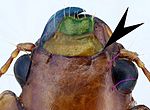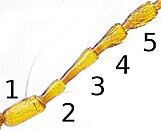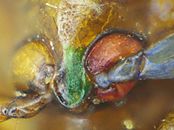Yellow canal beetle
| Yellow canal beetle | ||||||||||||
|---|---|---|---|---|---|---|---|---|---|---|---|---|

Yellow canal beetle Amara fulva |
||||||||||||
| Systematics | ||||||||||||
|
||||||||||||
| Scientific name | ||||||||||||
| Amara fulva | ||||||||||||
| ( OV Müller , 1776) |
The yellow canal beetle ( Amara fulva ) is a beetle from the family of ground beetles and the subfamily Harpalinae . The genus Amara is represented in Europe by 25 sub-genera. Amara fulva belongs to the subgenus Bradytus , which has eight species in Europe .
 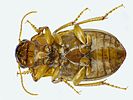  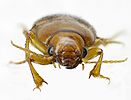
|
||
| Fig. 1: Different views (male) | ||
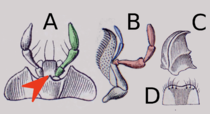
|

|
|
|
Fig. 2: Mouth parts according to Reitter A: chin with chin tooth, lower lip B: lower jaw with 1st and 2nd jaw buttons C: upper jaw; D: upper lip |
Fig. 3: green: upper lip, yellow: head shield, blue: upper jaw purple: supraorbital bristles arrow points to transverse furrow |
Fig. 4: Red head from below : 1. Blue jaw button : 2. Green jaw button : Lip button |

|

|
|
|
Fig. 5: 1st - 5th antennal segment hairiness from 4th segment |
Fig. 6: Two basal pits on the left pronotum colored |
Fig. 7: Transverse wrinkles on the pronotum |
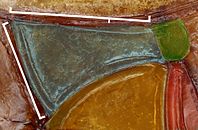
|
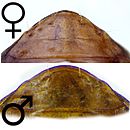
|
|
|
Fig. 8: Detail underside, lower center, golden yellow: rear breast; blue: episternum of the rear breast; green: epimeros of the rear breast; white: length and width of the episternum red: hind hip (head left) |
Fig. 9: Detail of underside green: Prosternal process on the right red-brown: Front hip blue: thigh ring and attachment of the thigh of the foreleg (left uncolored, head above) |
Fig. 10: Underside of the last abdominal segment in the female (above) and male (below) (upper end of the body) |

|
||
|
Fig. 11: Thighs of the middle pair of legs (left thigh ring, end of body below) |
Fig. 12: Anterior splint and tarsus blue arrow: plaster notch green arrow: large end pin red arrow: small end pin |
Fig. 13: Underside of the claw link of the hind leg, arrows point to pairs of bristles |
Notes on the name
The beetle was first described by OF Müller in 1776 under the scientific name Carabus fulvus . The short Latin characterization begins with the words totus flavus ( Latin completely yellow). This explains the species name fulvus , because fulvus also means yellow. The synonym ferruginea (Latin iron rust color) also refers to the body color. This also applies to the first part of the German name. But there are other species of the genus with a yellow-brown color, for example Amara montana .
The genus Carabus in the sense of Linnaeus was split up several times, specified and transformed into the family of ground beetles. Bonelli expanded the 25 genera that he found to 57 genera, which he classified into 22 taxonomic units (stipes, tribes). Among the new genera, he also defined the genus Amara using an identification key . The generic name Amara (Latin bitter) is, according to Audouin, an allusion to the difficulties that the study of the genus presents. The at Schenkling given different explanation of the name (not shiny) provides Schenkling himself with a question mark.
The subgenus Bradytus goes back to Stephens , who classifies Bradytus as a separate genus after Amara . He himself explains the name from old Gr. βραδυτής "bradytēs" with Latin "tarditas", meaning "slowness". In the description of Bradytus , Stephens mentions that the species in the subgenus are less agile than the other species in the subfamily Harpalinae.
Characteristics of the beetle
The 8 to 10.5 millimeter long beetle is lighter to darker rusty yellow and has a faint metallic sheen. The beetles get darker with age. The antennae and legs are a little paler yellow, as is the underside. Darker points may show through in the stripes of the elytra .
The head is smooth. A weak transverse furrow (black arrow in Fig. 3) separates the head shield (yellow in Fig. 3) from the forehead in a somewhat bulging manner. The eyes are bulging. Two bristles arise above the eyes, the supraorbital bristles (traced in purple on the right in Fig. 3). The first three links of the eleven-link antennae are bare except for the individual tactile bristles, the basic hairiness of the antennae does not begin until the fourth link (Fig. 5). The upper lip (Fig. 2D, green in Fig. 3) is only slightly wider than it is long and has a border at the front; a row of bristles rises from the front edge. The upper jaws (Fig. 2C, left blue in Fig. 3) protrude moderately. They are short and serrated at the base. As with all ground beetles, each lower jaw has two jaw buttons. The outer jaw palpation (red in Fig. 2B and 4 on the right) has four limbs, the third limb thickens outwards. It is shorter than the fourth link, which is elongated oval and truncated. The end link of the short inner jaw palpation (blue in Fig. 2B and 4) is slightly curved and spindle-shaped. The last link of the lip switch (green in Fig. 2A and 4) is also spindle-shaped. On the penultimate link there are three bristles, no fewer. The chin tooth, which is two-pointed in the yellow canal beetle (red arrow in Fig. 2A, two points can only be seen at full magnification), sits in the middle of the edge of the chin.
The pronotum (Fig. 6) is almost twice as wide as it is long, not just one and a half times as wide. It is slightly rounded. It narrows slightly towards the rear. It is weakly outlined in front of the back corners. The back angles are not rounded, they form an angle of a little under ninety degrees. The side edge of the pronotum has two bristles, not just one , as is the case with the genus Zabrus . The front bristle sits in the front third, the rear one in the rear corner (clearly visible in Fig. 6 on the right). There are two dotted, shallow dimples on either side near the base. Their shape and location provide important identifying features for the species and can be seen in Fig. 6. The dimples are clearly separated from each other (Fig. 6 black arrowhead). The outer fold of the outer dimple is clearly defined (Fig. 6 green arrowhead). It is not perpendicular to the base, but approaches the edge of the pronotum towards the rear, but reaches the base of the pronotum. The pronotum has a central longitudinal furrow. It is almost smooth and slightly wrinkled across the longitudinal furrow (Fig. 7, only clear with suitable lighting). In front the pronotum shows very scattered flat points , near the base there are more numerous and deeper points.
The elytra are briefly ovate. They are only slightly expanded and moderately arched behind the middle. They are striped and usually deeply dotted in the stripes.
The front chest is elongated backwards between the front hips (prosternal process). The prosternal process (tinted green in Fig. 6) is bare and clearly bordered. The episterns of the rear chest are located on the outside, laterally next to the rear breast (tinted blue in Fig. 8). They are longer in Amara fulva (horizontal white line in Fig. 8) than broad in front (oblique white line in Fig. 8). The last abdominal segment has one pore point on each side in the male and two deeply pierced pore points in the female, in which a bristle arises (in Fig. 10 there are three on one side).
The legs are very strong and especially the front legs are reinforced with thorns and spikes. The front leg shows a well-formed plaster notch in the rail (Fig. 12, blue arrow). The front splint has only a large spike at the tip (Fig. 12, green arrow). This is not three -pointed as in the genus Zezea , but simple. Next to the large spike is a very small second spike (Fig. 12, red arrow). In contrast to the subgenus Percosia, the thighs of the middle pair of legs (Fig. 11) have fewer than four bristles at the rear edge . The claw link of the hind tarsi has pairs of purse on the underside (black arrows in Fig. 13). The rear rails of the males in the Bradytes subgenus are hairy felt-like on the side facing the body. In the anterior tarsi of the males, the first three limbs are enlarged, the fourth limb is significantly narrower than the preceding ones, in the female the fourth limb is only slightly narrower than the third (Fig. 1 shows a male, Fig. 12 a female).
biology
The yellow canal beetle belongs to the species of the genus capable of flying. The beetle can be found in various dry locations, sandy forests, meadows, fields, heaths, sand pits and dunes on sandy soils with little vegetation. The imago is nocturnal and hides in the ground during the day. The beetles eat both vegetable and animal food. The species usually overwinters as a larva, sometimes as an imago. Reproduction occurs in autumn. The reproductive cycle is predominantly annual, occasionally two years. It comprises three larval stages. As a rule, the third larval stage overwinters.
In central Russia, in the Bryansk area , data on the biology of the species were evaluated based on over twelve hundred trapped individuals of the species, as well as on the basis of catches during soil sampling. The beetles appeared in the traps from the first half of June to October, with activity peaking in August. This applied equally to both sexes. Sexually mature animals were found from the second half of July to the end of September. At the end of August, over 90 percent of the animals were sexually mature. From October onwards, animals of the next generation were found that were not yet sexually mature and overwintered. The oviposition was observed from the end of July to the end of September with the maximum in the second half of August. Three to four mature eggs were usually found in the ovaries during this period.
Larvae were found in the traps from the second half of August. They were mainly active during the first half of September. Hibernating larvae were only found in excavations near the river under flea knotweed . For this purpose, the larvae created cells five to six millimeters in diameter in the soil into which the seeds of the flea knotweed were introduced. Only about three percent of the seeds were complete, mostly only the seed coats were left. No up to 21 seed coats were found per cell, usually one to three seed coats that had been pushed into the wall of the cell. The larvae lay curled up on their backs ( hibernation ). The larvae were found predominantly in a shallow soil depth of up to three centimeters and sometimes in high density - in ten samples between 99 and 403 individuals per square meter. In spring larvae were only found in soil samples, not in the traps. No larvae were found when samples were taken away from flea knotweed. On the other hand, the wintering adults were not found under flea knotweed, but under tufts of grass.
In the laboratory, the time from oviposition to hatching of the larvae was about eight days, the first larval stage lasted about 11 days, the second fourteen days. The third instar larva included wintering and was not observed in the laboratory. Since pupae were found outdoors from mid to late May, the duration of the third instar was calculated to be about 240 days. The pupal stage lasted between ten and seventeen days in the laboratory. The doll's cradle was left about three days after the imago hatched; the adults appeared in the laboratory from late May to mid-June. The duration of the developmental stages varied considerably in the individual individuals. The development from egg to beetle took 254 to 328 days. The ripe seeds of flea knotweed were sufficient food for rearing in the laboratory.
In other areas of the distribution area, partly similar, partly different activity patterns were observed. In Norway, the beetles appear later and disappear earlier. In southern Sweden, on the other hand, the animals appear in March and are observed until October with an activity maximum in June. Two activity maxima for the beetle were observed in Czechoslovakia, a maximum in June with the appearance of the new generation and one in August – September with reproduction. This two-peaked activity curve is caused by the beetle's resting phase during the summer, during which the beetle retreats to deeper, more humid layers of soil. The uniqueness of the activity, which is defined by the frequency of catches in traps, may be explained by the fact that the new generation does not appear, but remains in a kind of early summer rest under the surface of the earth.
distribution
The palaearctic species is widespread as far as western Siberia. It is absent in Europe only in Greece , Albania and European Turkey , as well as on Iceland and most of the Mediterranean islands. In Portugal their presence is questionable. The beetle was introduced into the United States .
literature
- Heinz Joy, Karl Wilhelm Harde, Gustav Adolf Lohse: The beetles of Central Europe . tape 2 . Adephaga 1. Elsevier, Spektrum, Akad. Verl., Munich 1976, ISBN 3-87263-025-3 . P. 236
- Ekkehard Wachmann , Ralph Platen, Dieter Barndt: Ground beetles - observation, way of life . 1st edition. Naturbuch-Verlag, Augsburg 1995, ISBN 3-89440-125-7 . P. 246
- Edmund Reitter: Fauna Germanica Volume I, Stuttgart 1908, p. 158 ff
Individual evidence
- ↑ Amara fulva at Fauna Europaea. Retrieved March 10, 2016
- ↑ Amara at Fauna Europaea. Retrieved March 10, 2016
- ↑ Bradytus (subgenus) in Fauna Europaea. Retrieved March 10, 2016
- ^ Edmund Reitter: Fauna Germanica Volume I, Stuttgart 1908, Plate 21, Figure 4 d, e, f, g
- ↑ Otto Frederik Müller: Zoologiae Danicae prodromus ... Hafnia (Copenhagen) 1776 p. 77, No. 830
- ↑ a b Sigmund Schenkling: Explanation of the scientific beetle names (species)
- ^ Franc-André Bonelli : Observations entomologiques 2nd partie in Mémoires de l'Academie Royale des Sciences (Turin) 1811-1812 Turin 1813 manuscript key, Amara with *
- ^ A b V. Audouin , A. Brullé : Histoire naturelle des Insectes tome 4, Coléoptères I, Paris 1834 Etymological explanation of the generic name in the Google book search, p. 391 Description of the species in the Google book search
- ↑ a b Sigmund Schenkling: Explanation of the scientific beetle names (genus)
- ^ A b James Francis Stephens: Illustration of British Entomologie Mandibulata Vol. 1, London 1828 p. 136 Description of the genre and explanation of names; P.67 key; S. 137 Species description
- ↑ Ludwig Redtenbacher: Fauna austriaca - Die Käfer second edition, Vienna 1858 p. 48 in the Google book search
- ^ WF Erichson: Natural history of the insects of Germany 1st division Coleoptera Berlin 1860 1st volume, 1st half p. 505
- ↑ Key Amara at coleo-net
- ^ A b Felix N. Kolesnikov, Ekaterina V. Malueva: Life history of Amara fulva (Coleoptera: Carabidae) in the southwest forest zone of the East European Plane in Eur. J. Entomology 112 (1): 127-134, 20156 doi : 10.14411 / eje.2015.009 as PDF
- ↑ Distribution map at Fauna Europaea ( Memento from March 24, 2016 in the Internet Archive )
